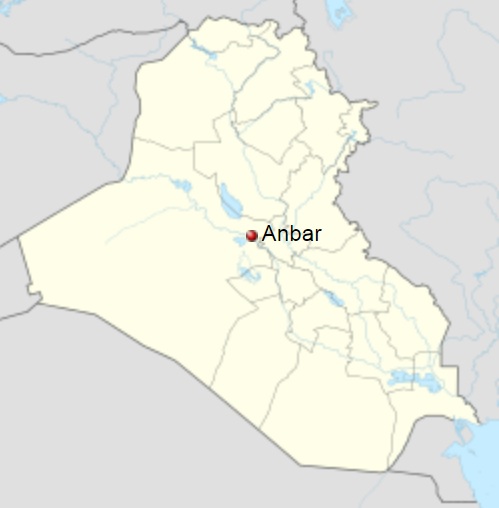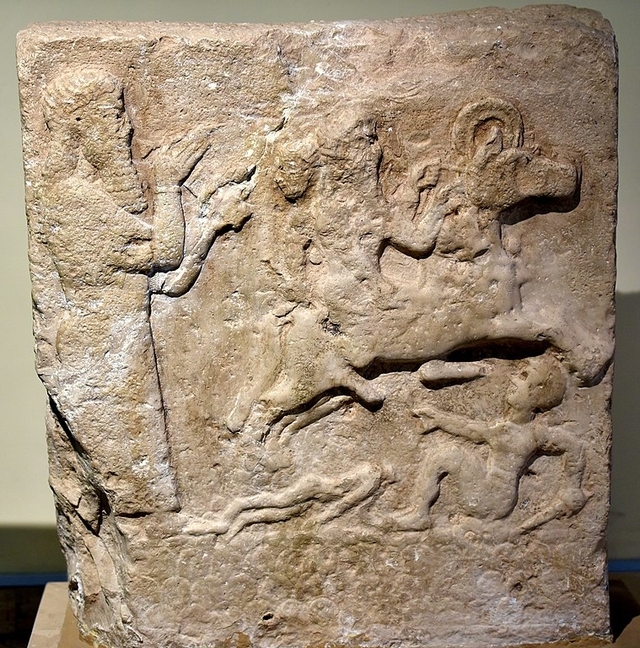
| ANBAR (TOWN)
Anbar's location inside Iraq Coordinates : 33°22.5' N 43°43' E
Country : Iraq
Anbar (Romanized: al-Anbar, Anbar) also known by its original ancient name, Peroz-Shapur, was an ancient and medieval town in central Iraq. It played a role in the Roman–Persian Wars of the 3rd–4th centuries, and briefly became the capital of the Abbasid Caliphate before the founding of Baghdad in 762. It remained a moderately prosperous town through the 10th century, but quickly declined thereafter. As a local administrative centre, it survived until the 14th century, but was later abandoned.
Its ruins are near modern Fallujah. The city gives its name to the Al-Anbar Governorate.
History
:
Assyrian wall relief showing a scribe and a horseman trampling enemies. From Anah, al-Anbar Governorate, Iraq. 9th - 7th century BCE. Iraq Museum The city is located on the left bank of the Middle Euphrates, at the junction with the Nahr Isa canal, the first of the navigable canals that link the Euphrates to the River Tigris to the east. The origins of the city are unknown, but ancient, perhaps dating to the Babylonian era and even earlier: the local artificial mound of Tell Aswad dates to c. 3000 BC.
Sasanian
period :
The city was fortified by a double wall, possibly through the use of Roman prisoner labour; it was sacked and burned after an agreement with its garrison in March 363 by the Roman emperor Julian during his invasion of the Sasanian Empire. It was rebuilt by Shapur II. By 420, it is attested as a bishopric, both for the Church of the East and for the Syriac Orthodox Church. The town's garrison was Persian, but it also contained sizeable Arab and Jewish populations. Anbar was adjacent or identical to the Babylonian Jewish center of Nehardea, and lies a short distance from the present-day town of Fallujah, formerly the Babylonian Jewish center of Pumbedita.
Islamic
period :
According to medieval Arabic sources, most of the inhabitants of the town migrated north to found the city of Hdatta south of Mosul. The famous governor al-Hajjaj ibn Yusuf cleared the canals of the city.
Abu'l-Abbas as-Saffah (r. 749–754), the founder of the Abbasid Caliphate, made it his capital in 752, constructing a new town half a farsakh (c. 2.5 kilometres (1.6 mi)) to the north for his Khurasani troops. There he died and was buried at the palace he had built. His successor, al-Mansur (r. 754–775), remained in the city until the founding of Baghdad in 762. The Abbasids also dug the great Nahr Isa canal to the south of the city, which carried water and commerce east to Baghdad. Thee Nahr al-Saqlawiyya or Nahr al-Qarma canal, which branches off from the Euphrates to the west of the city, is sometimes erroneously held to be the Nahr Isa, but it is more likely that it is to be identified with the pre-Islamic Nahr al-Rufayl.
It continued to be a place of much importance throughout the Abbasid period. Caliph Harun al-Rashid (r. 786–809) stayed at the town in 799 and in 803. The town's prosperity was founded on agricultural activities, but also on trade between Iraq and Syria. The town was still prosperous in the early 9th century, but the decline of Abbasid authority during the later 9th century exposed it to Bedouin attacks in 882 and 899. In 927, the Qarmatians under Abu Tahir al-Jannabi sacked the city, and the devastation was compounded by another Bedouin attack two years later. The town's decline accelerated after that: while the early 10th-century geographer Istakhri still calls the town modest but populous, with the ruins of the buildings of as-Saffah still visible, Ibn Hawqal and al-Maqdisi, who wrote a generation later, attest to its decline, and the diminution of its population.
The town was sacked again in 1262 by the Mongols under Kerboka. The Ilkhanids retained Anbar as an administrative centre, a role it retained until the first half of the 14th century; the Ilkhanid minister Shams al-Din Juvayni had a canal dug from the city to Najaf, and the city was surrounded by a wall of sun-dried bricks.
Ecclesiastical
history :
•
Narses fl. 540
It has had the following incumbents :
Source :
https://en.wikipedia.org/ |

